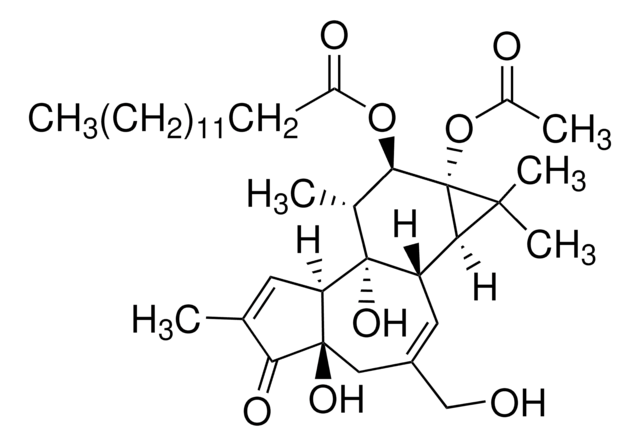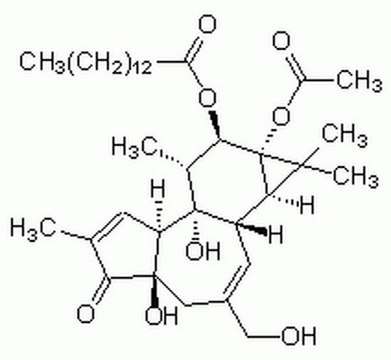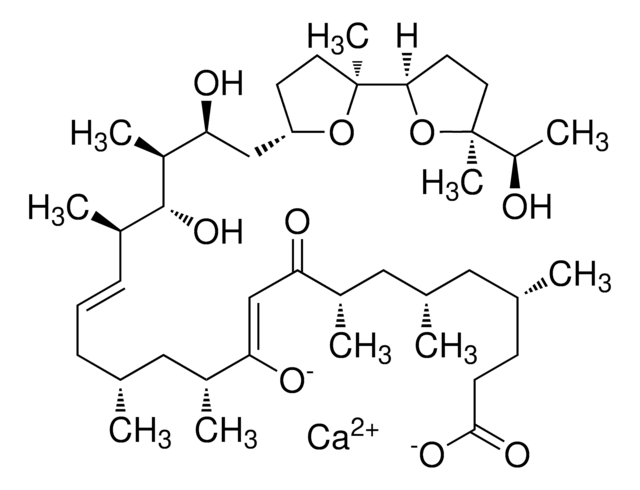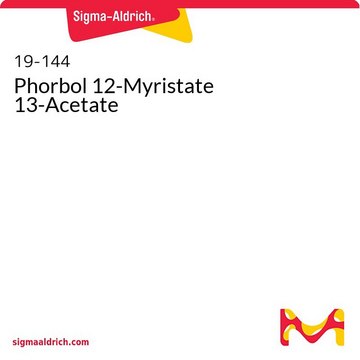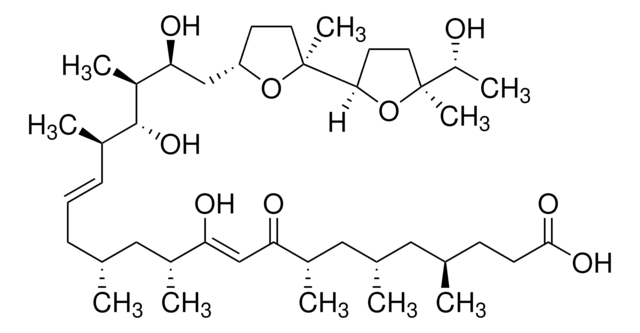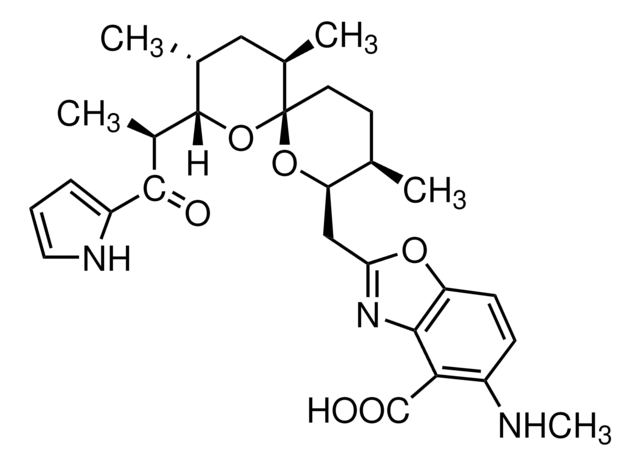79346
Phorbol 12-myristate 13-acetate
synthetic, ≥98.0% (TLC)
Synonym(s):
12-O-Tetradecanoylphorbol 13-acetate, 4β,9α,12β,13α,20-Pentahydroxytiglia-1,6-dien-3-one 12-tetradecanoate 13-acetate, PMA, TPA
About This Item
Recommended Products
Quality Level
Assay
≥98.0% (TLC)
form
film
quality
synthetic
solubility
chloroform: 10 mg/mL, clear, colorless to light yellow
storage temp.
−20°C
SMILES string
CCCCCCCCCCCCCC(=O)O[C@@H]1[C@@H](C)[C@@]2(O)C(C=C(CO)C[C@@]3(O)C2C=C(C)C3=O)C4C(C)(C)[C@]14OC(C)=O
InChI
1S/C36H56O8/c1-7-8-9-10-11-12-13-14-15-16-17-18-29(39)43-32-24(3)35(42)27(30-33(5,6)36(30,32)44-25(4)38)20-26(22-37)21-34(41)28(35)19-23(2)31(34)40/h19-20,24,27-28,30,32,37,41-42H,7-18,21-22H2,1-6H3/t24-,27+,28-,30-,32-,34-,35-,36-/m1/s1
InChI key
PHEDXBVPIONUQT-RGYGYFBISA-N
Looking for similar products? Visit Product Comparison Guide
Related Categories
Application
Biochem/physiol Actions
Other Notes
Signal Word
Danger
Hazard Statements
Precautionary Statements
Hazard Classifications
Acute Tox. 1 Dermal - Acute Tox. 1 Inhalation - Acute Tox. 2 Oral - Carc. 2 - Eye Dam. 1 - Resp. Sens. 1 - Skin Corr. 1B - Skin Sens. 1
Storage Class Code
6.1A - Combustible acute toxic Cat. 1 and 2 / very toxic hazardous materials
WGK
WGK 3
Personal Protective Equipment
Choose from one of the most recent versions:
Already Own This Product?
Find documentation for the products that you have recently purchased in the Document Library.
Which document(s) contains shelf-life or expiration date information for a given product?
If available for a given product, the recommended re-test date or the expiration date can be found on the Certificate of Analysis.
How do I get lot-specific information or a Certificate of Analysis?
The lot specific COA document can be found by entering the lot number above under the "Documents" section.
How should Product 79346, Phorbol 12-myristate 13-acetate - synthetic, be dissolved?
PMA is soluble in acetone, DMSO, ethyl acetate, ethanol and methylene chloride, but is practically insoluble in water. The solubility of 79346 has been tested in chloroform at a concentration of 10 mg/mL. Stock solutions of 20 mM can be prepared in DMSO and diluted into aqueous buffers.
Why do I not see any solid in the bottle of Product 79346, Phorbol 12-myristate 13-acetate - synthetic?
Phorbol 12-myristate 13-acetate may be an invisible film in the bottle.
What is the difference between product 79346, Phorbol 12-myristate 13-acetate - synthetic, and molecular biology grade product P1585?
Product P1585 has been tested and found suitable for stimulation of interleukin 2 production of Jurkat cells. Product 79346 has not tested in this application.
How can I store the Product 79346, Phorbol 12-myristate 13-acetate - synthetic (PMA), solution solution? How long?
Stock solutions in DMSO can be stored protected from light as aliquots at -20°C for at least 6 months, or at 2-8°C for up to 3 months.
How do I find price and availability?
There are several ways to find pricing and availability for our products. Once you log onto our website, you will find the price and availability displayed on the product detail page. You can contact any of our Customer Sales and Service offices to receive a quote. USA customers: 1-800-325-3010 or view local office numbers.
What is the Department of Transportation shipping information for this product?
Transportation information can be found in Section 14 of the product's (M)SDS.To access the shipping information for this material, use the link on the product detail page for the product.
My question is not addressed here, how can I contact Technical Service for assistance?
Ask a Scientist here.
Articles
Cancer research has revealed that the classical model of carcinogenesis, a three step process consisting of initiation, promotion, and progression, is not complete.
Our team of scientists has experience in all areas of research including Life Science, Material Science, Chemical Synthesis, Chromatography, Analytical and many others.
Contact Technical Service